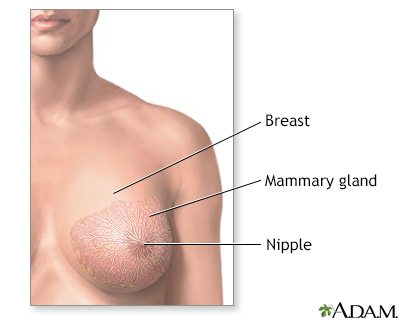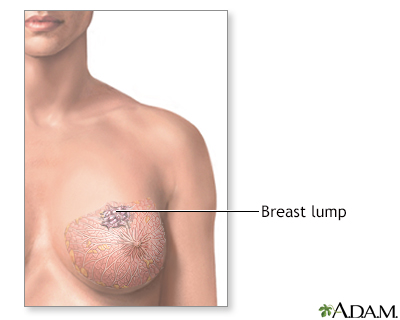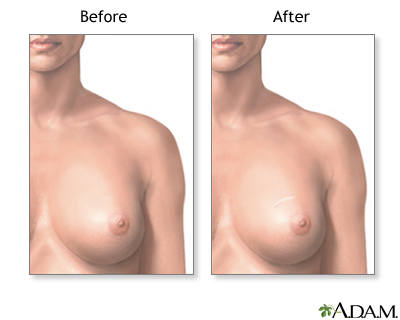Health exams for: #AGEGROUP#
The following exams, tests, and procedures are recommended for #AGEGROUPLOWER#.#FEMALETEXT#
Select a link from the list below to learn how and why each test is performed, as well how to prepare for it.

The following exams, tests, and procedures are recommended for #AGEGROUPLOWER#.#FEMALETEXT#
Select a link from the list below to learn how and why each test is performed, as well how to prepare for it.




The female breast is composed mainly of fatty tissue interspersed with fibrous or connective tissue. The circular region around the nipple is often a different color or pigmented. This region is called the areola.
The female breast is composed mainly of fatty tissue interspersed with fibrous or connective tissue. The circular region around the nipple is often a...
Most breast lumps are not diagnosed by a healthcare provider, but are detected by women who give themselves breast self-examinations. Any breast lump that persists beyond a few days should be reported to a healthcare provider. Almost two-thirds of all breast lumps are benign, but the chance of a malignant lump is greatly increased if the woman is past menopause. Ultrasound and mammogram may be used to see if a lump is a cyst filled with fluid or a solid mass of tissue. If the lump is a cyst, it can be left alone or aspirated if it causes symptoms. If a cyst appears suspicious on imaging, needle aspiration or needle biopsy can be performed. If the lump is a solid mass, the next step is usually a needle biopsy performed by a radiologist or breast specialist. The tissue is checked by a pathologist to see if it is cancer or not.
Most breast lumps are not diagnosed by a healthcare provider, but are detected by women who give themselves breast self-examinations. Any breast lump...
Sometimes a mass needs to be removed to see if cancer is present. This is called an excisional biopsy. While the patient is awake and pain-free (using local anesthesia) or asleep and pain-free (using general anesthesia), an incision is made over the lump. The length and position of the incision will depend on the size and location of the lump that needs to be removed. After the lump is removed in one piece, it is sent to the pathologist for a microscopic exam. The final report usually is done several days later.
Sometimes a mass needs to be removed to see if cancer is present. This is called an excisional biopsy. While the patient is awake and pain-free (usin...
The outcome of the excisional biopsy depends on the type of lump found. If the lump is benign, no further treatment is required. If the lump is malignant, the treatment can include surgery, radiation, chemotherapy and endocrine therapy. The choice of treatment will be discussed with you by specialists in each area.
The outcome of the excisional biopsy depends on the type of lump found. If the lump is benign, no further treatment is required. If the lump is malig...
Review Date: 2/2/2023
Reviewed By: Mark Levin, MD, Hematologist and Oncologist, Monsey, NY. Review provided by VeriMed Healthcare Network. Also reviewed by David C. Dugdale, MD, Medical Director, Brenda Conaway, Editorial Director, and the A.D.A.M. Editorial team. Editorial update 06/05/2023.



